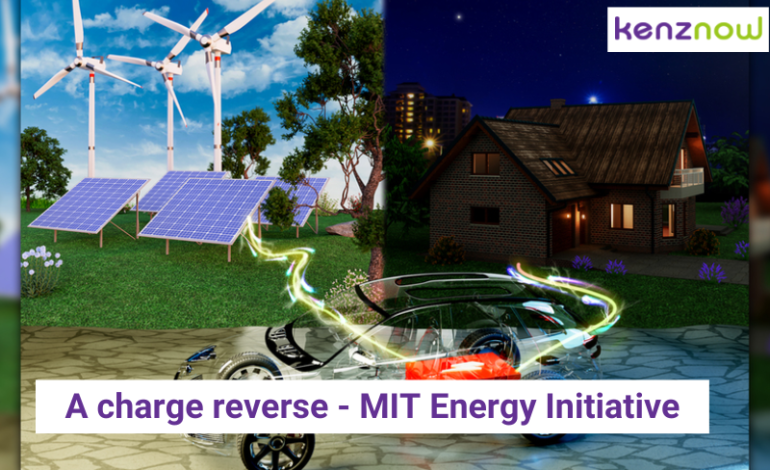
A charge reverse – MIT Energy Initiative – Kenznow Newsletter
Hallo Freunde Guten Morgen! Welcome to Kenznow Newsletter CAMPUS STORY A charge reverse – MIT Energy Initiative Source- news.mit.edu Electric vehicle (EV) owners are used to connecting their vehicles to
Hallo Freunde
Guten Morgen!
Welcome to Kenznow Newsletter
CAMPUS STORY
A charge reverse – MIT Energy Initiative
Source- news.mit.edu
Electric vehicle (EV) owners are used to connecting their vehicles to charging ports at home and at work to refuel their batteries with energy from the power grid. But in a short while, these drivers’ automobiles will also be able to reverse the flow and deliver electrons back to the grid when they plug in. According to new research from an MIT team published in the journal Energy Advances, as the number of EVs rises, the fleet’s batteries might function as a cost-effective, large-scale energy source, with potentially significant effects on the energy transition.
The group’s work is the first in-depth, systems-based analysis of future power systems, and it is based on a novel combination of computational models that integrate objectives for reducing carbon emissions, generation of variable renewable energy (VRE), and the costs associated with constructing infrastructure for energy storage, production, and transmission.
Jim Owens, lead author and a doctoral student in the MIT Department of Chemical Engineering, Emre Gencer, a principal research scientist at the MIT Energy Initiative (MITEI), and Ian Miller, a research specialist for MITEI at the time of the study make the team for research.
There will be more demand for energy if emissions-free driving becomes more popular. For example, the team discovered that participation from just 13.9 percent of the region’s 8 million light-duty EVs resulted in the displacement of 14.7 gigawatts of stationary energy storage in their case study of a hypothetical New England power system with severe carbon limitations. We do not need to develop or invest in additional natural gas turbines, according to Owens, because V2G technology can inject electricity back into the system to cover these instances.
Through their analysis, they discovered advantages for V2G applications in power systems with all varying degrees of carbon emission controls, including one with no emissions limits at all. As a result of V2G, the system was able to save anywhere from $183 million and $1,326 million, with EV participation rates ranging from 5 to 80 percent.
HEARD ON WEB
Yale researchers made a robot that travels by land and water with morphing limbs
Source: Yale University
Yale researchers have developed an amphibious robot turtle with limbs that can change its shape, stiffness, and behavior to its surroundings. They have dubbed this process “adaptive morphogenesis.”
The robot, known as ART (Amphibious Robotic Turtle), was inspired by land and aquatic turtles. The robot has morphing limbs that may change shape, stiffness, and behavior depending on the surrounding conditions. The limbs change shape when moving from one environment to other using materials with varying stiffness and artificial muscles. ART may move around the ground with a variety of four-legged terrestrial gaits while it is on its legs. ART can transform its legs into flippers once it is near a body of water, allowing it to swim with lift- and drag-based aquatic gaits.
By using form adaptation to employ the same elements for propulsion in both water and land conditions, the robot differentiates from existing amphibious robots. In other methods, the same robot is given various propulsive systems, each of which is used differently depending on the environment. This might result in energy inefficiencies.
What can be done with an amphibious robot that was inspired by turtles and tortoises? There are a lot of potential applications. The applications done by the researchers have concentrated on including ocean farming, diver support, and monitoring of coastal ecosystems. The robot will also assist researchers in their study of the mechanics of mobility in various environmental transition zones as well as the challenging surf zone, where waves, currents, and turbidity provide unique challenges for robotic systems.
LIFELONG LEARNING CORNER
Trends that influenced Lifelong Learning in 2022
Higher education is developing and changing like many other industries have over the past few years. An increasing number of individuals are relying on postsecondary education to provide them with fast routes to credentials that will enable them to land a better job or keep the one they now have. It is a known fact that non-degree education is giving students a chance to showcase their skills while enhancing other learning methods.
PASSING BY
Canadian immigration targets 300,000 by March 2023
Canada plans to grant citizenship to 300,000 immigrants during this fiscal year, which runs from 2022 to 2023. According to CIC News, the document mentions that the IRCC process 300,000 new citizens and 285,000 decisions overall by March 31, 2023.
This fiscal year’s 300,000 citizenship milestone represents a significant improvement above the pre-pandemic targets of 2019–2020 and 2021–2022. In 2019–2020, 253,000 citizenship petitions were processed and 217,000 new citizens were accepted in 2021–2022.
Indian nationals top the list for applications for all types of Canadian visas, including those for employment, study, and tourist visas as well as those for permanent residence. As previously reported, India is the country with the highest number of applicants for permanent residency (PR) in Canada, accounting for roughly one-third of arrivals in 2021.
Based on 2016 statistics, IANS stated that 1.4 million persons in Canada are Indians. According to the data, around 100,000 Indians entered Canada last year through the Temporary Foreign Worker Program, and roughly 130,000 received work visas through the International Mobility Program. Over 210,000 permanent residents also became Canadian citizens in 2021–2022.
In comparison to the number of visa applications the nation received in 2019, there was a dramatic increase of 55% in 2022. Experts attribute the rapid increase in visa requests that have contributed to the backlog to the pandemic.
TRIVIA
Know the Language
German
The German language is the official language of both Germany and Austria and one of the official languages of Switzerland. German is a member of the West Germanic branch of the Indo-European language family. The appearance of the German language begins in the Early Middle Ages. There are over 130 million native German speakers worldwide.
Till next issue.
Ciao!
Team Kenznow



